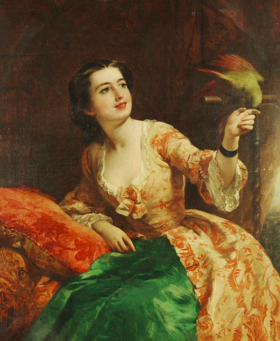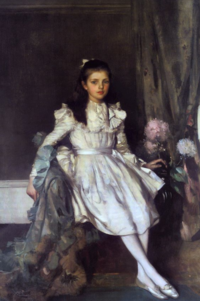Juliya of Susa
|
| |||||||||||||||
Juliya Rose (Common: Julia Rose, High Imperial: Iulia Rosa), of House Basrid, was the firstborn daughter to the 3rd Count of Susa, Anthony Alexios Basrid, and his Raevir wife Valeria. She was raised within a scholastic household and thus undoubtedly inclined towards literature and the arts, making her favourable at Imperial court for her artistic flair and somewhat bohemian behaviour. After being named the second ever 'Ruby' of her respective Orenian social season, she went on to wed Prince George Alexander and thus became an Aldersbergian Princess and later Countess of Aldersberg by marriage. Said union produced five children, including the heir to the House of Novellen-Aldersberg.
For the majority of her adult life, Juliya was employed under the Ministry of Foreign Affairs as an official diplomat, frequenting a variety of nations across Almaris on behalf of the empire.
Contents
Early Life
Juliya Rose was born beside her twin brother, Darius Basrid, on the 23rd of Sun's Smile, 1808, in the Orenian capital city of Providence. Her earliest years were spent in the Imperial apartment belonging to her family, plans for the construction of Susa having only just begun, and so education was always a primary factor - especially in her father's speciality of reading and writing. Even in these years where toys were Juliya's most important companion, she was still able to recognize the abundance of vast stories, art, and poetry that seemed to encompass her everyday life and it was only sure to follow her into adolescence.
While she was known to shy away from large gatherings as a child, these years are where she met her lifelong friends Maude Fitzpeter and Wilhelm Lucius, Baron of Carrington. As she grew, so did the new generation of Orenian children and Juliya proved to be quite the paragon likely due to her esthetic interests and new-found confidence aided by her growing friendship with the children of the court.
Her childhood summers were frequently spent in the countryside estate of her grandmother, Elizabeth Anne, namely Rosemoor — of which later went on to become the namesake of a progressive bill allowing women the right to inherit equally. For a young Juliya the Princess Imperial acted as the main maternal figure in her life, as opposed to her Raev mother who was largely uninvolved at court and Orenian society in general and instead preferred home life. It was during these annual visits where Juliya's adoration for literature and poetry soared and, consequently, she cherished Rosemoor as not only the source of her early creativity and warm memories but as the ideal embodiment of a modern woman. Supported by the Princess Imperial herself, a young Juliya found herself fascinated by her teachings and mentorship, of which would later go on to prove extremely substantial to life for women in the 19th century.
Growing prone to romanticizing the world around her, the Spring of 1822 was an especially productive one for the nearing-adolescent Basrid. Her love for reading became a love for writing and, under the tuition of Maisie Adelheid d'Arkent, she began to practice and write Poetry of her own. She also undertook harp lessons, though she was unable to name herself fluent till much later in her teenage years.
Marriage
Amidst the season of the time rumours began to float around that Juliya and one Aldersbergian prince, namely George Alexander, were caught seeming rather intimate in the Augustine gardens just months after it was published in Petite Potins, [1] a gossip paper at the time, that the Lady Juliya had been spotted in a maze with the Baron of Carrington. Presumably to avoid further speculation, the two rushed into a privately-held ceremony of marriage [2] admitting only dynasts of the houses of Aldersberg, Susa, Rosemoor, and Crestfall. Once such an occasion had concluded, Juliya of Susa became publicly known as the Princess George of Aldersberg.
The Social Season of 1827
After much of her childhood was spent anticipating it, her respective debut season was certainly momentous for the young woman Juliya had become by that very Spring. Having been a somewhat notable peer amidst the generation she had grown up with - Juliya, among a few other ladies, was thought to have been an exceptionally strong contender for the afamed title of Ruby. At the debut itself Juliya wore a considerably simple white dress, though she adorned it generously with Rhenyar silks and jewellery. For that time in Oren, fashion was exceptionally restrictive. Coined as 'Alto-Modernism', clothing amongst female heartlanders was largely structured and unvaried. This celebration, or indeed representation of the Rhenyari culture is what thrust her to the limelight and subsequently won her the coveted title of Ruby.Her victory, however, did not come without it's controversy. It should be noted many at the time found the crowning of the Basrid to be utterly unjust considering the close relationship and familial ties that she held with the Princess Imperial and many publications at the time were enthralled with heated debates and nepotism allegations. Said quarrels mostly fizzled out after a fair few months, though not before the infamous Garden Party hosted by the Countess of Renzfeld where attendees were shocked to witness a drink being spilt over the new Ruby in what many of Juliya's close confidants described as a 'fit of jealousy'.
The remaining months of the season were well for the girl, including her first publishing of work titled 'The Countess' Croquet' [3] said to be loosely based on the events of one croquet game that Spring.
As the Princess George
Juliya fell pregnant half a year after the marriage had occurred and was recorded to have not been seen the entirety of her second or third trimesters, instead isolating herself up at Aldersberg out of apparent fears of excessive weight gain. Once the house announced the birth of the then grand-heir, the princess Juliya was not seen in public for a further six months, choosing instead to spend her postpartum period in the familiar Fakhr Oasis. After only a brief reintroduction to the courts and Imperial life Juliya set off again travelling for the ministry, making it a typical year to spend some months equally in the Fakhr Oasis, Yong Ping and Providence.
This was somewhat criticized and seemed to create a strain on herself and her budding family as the years went on, and so with that surely in mind the princess returned to the Empire, taking a lengthy break from both the ministry and Imperial duties. During these years, Juliya raised her son and gave birth to two more children, both daughters.
Career
The Ministry of Foreign Affairs
Said to have enrolled a mere month after her eighteenth birthday, Juliya spent a majority of her adult life employed under the foreign ministry and thus travelling to many nations across Almaris on behalf of the empire. In particular, she spent much of her time on excursions to both the Jade State of Yong Ping and the Fakhr Oasis - the latter of which she, somewhat controversially, had spent her postpartum period after giving birth to her first son, Edward.
Death
Shortly after the birth of her fifth and final child, Juliya once more retired from the public eye to spend her postpartum period away from stress and duty. Only this time, however, the Countess did not ever return from this state. Years passed by with utter silence from both the Imperial family and the direct Aldersbergian line, with the only acknowledgment to surface a mere spread of rumours regarding the unfortunate passing of Juliya's first daughter Georgiana. Several more years progressed before an official albeit brief statement was published by House Aldersberg stating only that the princess George had passed due to 'unforeseen circumstances'.
Titles and Styles
- 1808 - 1827 The Honourable, Lady Juliya Rose of Susa
- 1828 - 1848 Her Imperial Highness, The Princess George of Aldersberg
- 1849 - 1860 Her Imperial Highness, The Countess of Aldersberg
Issue
| Name | Birth | Death | Marriage | |||||||||||||||||||||||||||||||||||||||||||||||||||||||||||||||||||||||||||||||||||||||||||||||||||||||||||||||||||||||||||||||||||||||||||||||||||||||||||||||||||||||||||||||||||||||||||||||||||||||||||||||||||||||||||||||||||||||||||||||||||||||||||||||||||||||||||||||||||||||||||||||||||||||||||||||||||||||||||||||||||||||||||||||||||||||||||||||||||||||||||||||||||||||||||||||||||||||||||||||||||||||||||||||||||||||||||||||||||||||||||||||||||||||||||||||||||||||||||||||||||||||||||||||||||||||||||||||
|---|---|---|---|---|---|---|---|---|---|---|---|---|---|---|---|---|---|---|---|---|---|---|---|---|---|---|---|---|---|---|---|---|---|---|---|---|---|---|---|---|---|---|---|---|---|---|---|---|---|---|---|---|---|---|---|---|---|---|---|---|---|---|---|---|---|---|---|---|---|---|---|---|---|---|---|---|---|---|---|---|---|---|---|---|---|---|---|---|---|---|---|---|---|---|---|---|---|---|---|---|---|---|---|---|---|---|---|---|---|---|---|---|---|---|---|---|---|---|---|---|---|---|---|---|---|---|---|---|---|---|---|---|---|---|---|---|---|---|---|---|---|---|---|---|---|---|---|---|---|---|---|---|---|---|---|---|---|---|---|---|---|---|---|---|---|---|---|---|---|---|---|---|---|---|---|---|---|---|---|---|---|---|---|---|---|---|---|---|---|---|---|---|---|---|---|---|---|---|---|---|---|---|---|---|---|---|---|---|---|---|---|---|---|---|---|---|---|---|---|---|---|---|---|---|---|---|---|---|---|---|---|---|---|---|---|---|---|---|---|---|---|---|---|---|---|---|---|---|---|---|---|---|---|---|---|---|---|---|---|---|---|---|---|---|---|---|---|---|---|---|---|---|---|---|---|---|---|---|---|---|---|---|---|---|---|---|---|---|---|---|---|---|---|---|---|---|---|---|---|---|---|---|---|---|---|---|---|---|---|---|---|---|---|---|---|---|---|---|---|---|---|---|---|---|---|---|---|---|---|---|---|---|---|---|---|---|---|---|---|---|---|---|---|---|---|---|---|---|---|---|---|---|---|---|---|---|---|---|---|---|---|---|---|---|---|---|---|---|---|---|---|---|---|---|---|---|---|---|---|---|---|---|---|---|---|---|---|---|---|---|---|---|---|---|---|---|---|---|---|---|---|---|---|---|---|---|---|---|---|---|---|---|---|---|---|---|---|---|---|---|---|---|---|---|---|---|---|---|---|---|---|---|---|---|---|---|---|---|---|---|---|---|---|---|---|---|---|---|---|---|---|---|---|---|---|---|---|---|---|---|---|---|---|---|---|---|---|---|---|---|---|---|---|---|---|---|---|---|---|---|---|---|---|---|---|---|---|---|---|---|---|---|---|---|---|---|---|---|---|---|---|---|---|---|---|---|---|---|---|---|---|---|---|---|
| Edward Clement Novellen-Aldersberg | 9th of The Amber Cold, 1829 | 1878 | Anne of Sunholdt | The firstborn child of Juliya and George. Heir to the county of Aldersberg. | ||||||||||||||||||||||||||||||||||||||||||||||||||||||||||||||||||||||||||||||||||||||||||||||||||||||||||||||||||||||||||||||||||||||||||||||||||||||||||||||||||||||||||||||||||||||||||||||||||||||||||||||||||||||||||||||||||||||||||||||||||||||||||||||||||||||||||||||||||||||||||||||||||||||||||||||||||||||||||||||||||||||||||||||||||||||||||||||||||||||||||||||||||||||||||||||||||||||||||||||||||||||||||||||||||||||||||||||||||||||||||||||||||||||||||||||||||||||||||||||||||||||||||||||||||||||||||||||
| Georgiana Maria Novellen-Aldersberg | 14th of The Grand Harvest, 1837 | 1854 | Unwed | The secondborn child and firstborn daughter of Juliya and George. Named after her aunt, Georgiana Beatrix. Died as a teenager due to her childhood illness. | ||||||||||||||||||||||||||||||||||||||||||||||||||||||||||||||||||||||||||||||||||||||||||||||||||||||||||||||||||||||||||||||||||||||||||||||||||||||||||||||||||||||||||||||||||||||||||||||||||||||||||||||||||||||||||||||||||||||||||||||||||||||||||||||||||||||||||||||||||||||||||||||||||||||||||||||||||||||||||||||||||||||||||||||||||||||||||||||||||||||||||||||||||||||||||||||||||||||||||||||||||||||||||||||||||||||||||||||||||||||||||||||||||||||||||||||||||||||||||||||||||||||||||||||||||||||||||||||
| Elisabeth Helaine Novellen-Aldersberg | 24th of Malins Welcome, 1838 | 1860 | Unwed | The thirdborn child of Juliya and George. Missing and presumed dead. | ||||||||||||||||||||||||||||||||||||||||||||||||||||||||||||||||||||||||||||||||||||||||||||||||||||||||||||||||||||||||||||||||||||||||||||||||||||||||||||||||||||||||||||||||||||||||||||||||||||||||||||||||||||||||||||||||||||||||||||||||||||||||||||||||||||||||||||||||||||||||||||||||||||||||||||||||||||||||||||||||||||||||||||||||||||||||||||||||||||||||||||||||||||||||||||||||||||||||||||||||||||||||||||||||||||||||||||||||||||||||||||||||||||||||||||||||||||||||||||||||||||||||||||||||||||||||||||||
| Joseph Maximilian Novellen-Aldersberg | 3rd of The Grand Harvest, 1841 | 1889 | Alexandra Helane | The fourthborn child of Juliya and George. | ||||||||||||||||||||||||||||||||||||||||||||||||||||||||||||||||||||||||||||||||||||||||||||||||||||||||||||||||||||||||||||||||||||||||||||||||||||||||||||||||||||||||||||||||||||||||||||||||||||||||||||||||||||||||||||||||||||||||||||||||||||||||||||||||||||||||||||||||||||||||||||||||||||||||||||||||||||||||||||||||||||||||||||||||||||||||||||||||||||||||||||||||||||||||||||||||||||||||||||||||||||||||||||||||||||||||||||||||||||||||||||||||||||||||||||||||||||||||||||||||||||||||||||||||||||||||||||||
| Eleanor Christina Novellen-Aldersberg | 19th of Sun's Smile, 1843 | 1866 | Reginald d'Emyth | The fifthborn child of Juliya and George. | ||||||||||||||||||||||||||||||||||||||||||||||||||||||||||||||||||||||||||||||||||||||||||||||||||||||||||||||||||||||||||||||||||||||||||||||||||||||||||||||||||||||||||||||||||||||||||||||||||||||||||||||||||||||||||||||||||||||||||||||||||||||||||||||||||||||||||||||||||||||||||||||||||||||||||||||||||||||||||||||||||||||||||||||||||||||||||||||||||||||||||||||||||||||||||||||||||||||||||||||||||||||||||||||||||||||||||||||||||||||||||||||||||||||||||||||||||||||||||||||||||||||||||||||||||||||||||||||
| Ancestors of Juliya of Susa | ||||||||||||||||||||||||||||||||||||||||||||||||||||||||||||||||||||||||||||||||||||||||||||||||||||||||||||||||||||||||||||||||||||||||||||||||||||||||||||||||||||||||||||||||||||||||||||||||||||||||||||||||||||||||||||||||||||||||||||||||||||||||||||||||||||||||||||||||||||||||||||||||||||||||||||||||||||||||||||||||||||||||||||||||||||||||||||||||||||||||||||||||||||||||||||||||||||||||||||||||||||||||||||||||||||||||||||||||||||||||||||||||||||||||||||||||||||||||||||||||||||||||||||||||||||||||||||||||||
|---|---|---|---|---|---|---|---|---|---|---|---|---|---|---|---|---|---|---|---|---|---|---|---|---|---|---|---|---|---|---|---|---|---|---|---|---|---|---|---|---|---|---|---|---|---|---|---|---|---|---|---|---|---|---|---|---|---|---|---|---|---|---|---|---|---|---|---|---|---|---|---|---|---|---|---|---|---|---|---|---|---|---|---|---|---|---|---|---|---|---|---|---|---|---|---|---|---|---|---|---|---|---|---|---|---|---|---|---|---|---|---|---|---|---|---|---|---|---|---|---|---|---|---|---|---|---|---|---|---|---|---|---|---|---|---|---|---|---|---|---|---|---|---|---|---|---|---|---|---|---|---|---|---|---|---|---|---|---|---|---|---|---|---|---|---|---|---|---|---|---|---|---|---|---|---|---|---|---|---|---|---|---|---|---|---|---|---|---|---|---|---|---|---|---|---|---|---|---|---|---|---|---|---|---|---|---|---|---|---|---|---|---|---|---|---|---|---|---|---|---|---|---|---|---|---|---|---|---|---|---|---|---|---|---|---|---|---|---|---|---|---|---|---|---|---|---|---|---|---|---|---|---|---|---|---|---|---|---|---|---|---|---|---|---|---|---|---|---|---|---|---|---|---|---|---|---|---|---|---|---|---|---|---|---|---|---|---|---|---|---|---|---|---|---|---|---|---|---|---|---|---|---|---|---|---|---|---|---|---|---|---|---|---|---|---|---|---|---|---|---|---|---|---|---|---|---|---|---|---|---|---|---|---|---|---|---|---|---|---|---|---|---|---|---|---|---|---|---|---|---|---|---|---|---|---|---|---|---|---|---|---|---|---|---|---|---|---|---|---|---|---|---|---|---|---|---|---|---|---|---|---|---|---|---|---|---|---|---|---|---|---|---|---|---|---|---|---|---|---|---|---|---|---|---|---|---|---|---|---|---|---|---|---|---|---|---|---|---|---|---|---|---|---|---|---|---|---|---|---|---|---|---|---|---|---|---|---|---|---|---|---|---|---|---|---|---|---|---|---|---|---|---|---|---|---|---|---|---|---|---|---|---|---|---|---|---|---|---|---|---|---|---|---|---|---|---|---|---|---|---|---|---|---|---|---|---|---|---|---|---|---|---|---|---|---|---|---|---|---|---|---|---|---|---|---|---|---|---|---|---|---|---|---|---|
|
|
||||||||||||||||||||||||||||||||||||||||||||||||||||||||||||||||||||||||||||||||||||||||||||||||||||||||||||||||||||||||||||||||||||||||||||||||||||||||||||||||||||||||||||||||||||||||||||||||||||||||||||||||||||||||||||||||||||||||||||||||||||||||||||||||||||||||||||||||||||||||||||||||||||||||||||||||||||||||||||||||||||||||||||||||||||||||||||||||||||||||||||||||||||||||||||||||||||||||||||||||||||||||||||||||||||||||||||||||||||||||||||||||||||||||||||||||||||||||||||||||||||||||||||||||||||||||||||||||||



